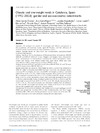Identificador persistente para citar o vincular este elemento:
https://accedacris.ulpgc.es/jspui/handle/10553/44795
| Título: | Obesity and overweight trends in Catalonia, Spain (1992-2003): Gender and socio-economic determinants | Autores/as: | García-Álvarez, Alicia Serra-Majem, Lluís Ribas-Barba, Lourdes Castell, Conxa Foz, Marius Uauy, Ricardo Plasencia, Antoni Salleras, Lluís |
Clasificación UNESCO: | 32 Ciencias médicas 3206 Ciencias de la nutrición |
Palabras clave: | Waist Circumference Educational-Level Energy Density Prevalence Weight, et al. |
Fecha de publicación: | 2007 | Publicación seriada: | Public Health Nutrition | Resumen: | Objective: To evaluate the trends of overweight and obesity prevalences in the population of Catalonia, Spain, aged 18-75 years, and the influence of socio-economic determinants on these prevalence trends.Design: Analysis based on data from two representative population-based cross-sectional surveys.Setting: Data from the two Evaluations of Nutritional Status in Catalonia (ENCAT 1992-93 and ENCAT 2002-03), Spain. Weights and heights were obtained by direct measurement in standardised conditions by trained interviewers. Overweight and obesity were defined using body mass index (BMI) and waist circumference (WC), categorised according to WHO criteria.Subjects: In total, 1015 men and 1233 women from ENCAT 1992-93, and 791 men and 924 women from ENCAT 2002-03.Results: Mean BMI and mean WC were higher in males in 2002-03 as compared to 1992-93, while for females mean BMI was lower except for the youngest group, and mean WC was higher. In men, overall BMI overweight prevalence remained stable (from 44.1% to 43.7%), while obesity increased (from 9.9% to 16.6%); total WC overweight remained stable (from 21.7 to 23.8%), while WC obesity increased (from 13.1% to 24.4%). In women, overall BMI overweight increased (from 29.1% to 30.1%), whereas BMI obesity remained stable (from 15.0% to 15.2%); total WC overweight decreased (from 21.8% to 17.7%), while WC obesity increased (from 24.5% to 31.1%). The socio-economic and education variables had an influence BMI and WC overweight and obesity rates mainly on females in both surveys and on the youngest men only in the 1992-93 survey.Conclusions: Ten-year trends indicate that Catalan males are getting bigger overall (BMI) and around the waistline (WC), while Catalan females only have bigger waistlines (WC). BMI male obesity prevalence has overtaken that of females. WC obesity continues to be more prevalent among females than males. | URI: | https://accedacris.ulpgc.es/handle/10553/44795 | ISSN: | 1368-9800 | DOI: | 10.1017/S1368980007000973 | Fuente: | Public Health Nutrition [ISSN 1368-9800], v. 10, p. 1368-1378 |
| Colección: | Artículos |
Citas SCOPUSTM
73
actualizado el 08-jun-2025
Citas de WEB OF SCIENCETM
Citations
67
actualizado el 08-jun-2025
Visitas
94
actualizado el 30-nov-2024
Descargas
135
actualizado el 30-nov-2024
Google ScholarTM
Verifica
Altmetric
Comparte
Exporta metadatos
Los elementos en ULPGC accedaCRIS están protegidos por derechos de autor con todos los derechos reservados, a menos que se indique lo contrario.
